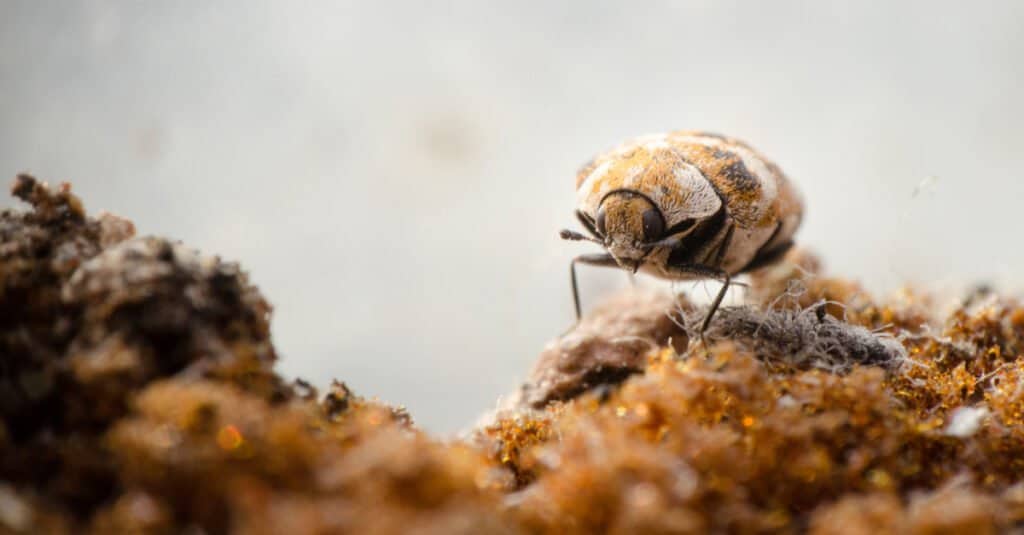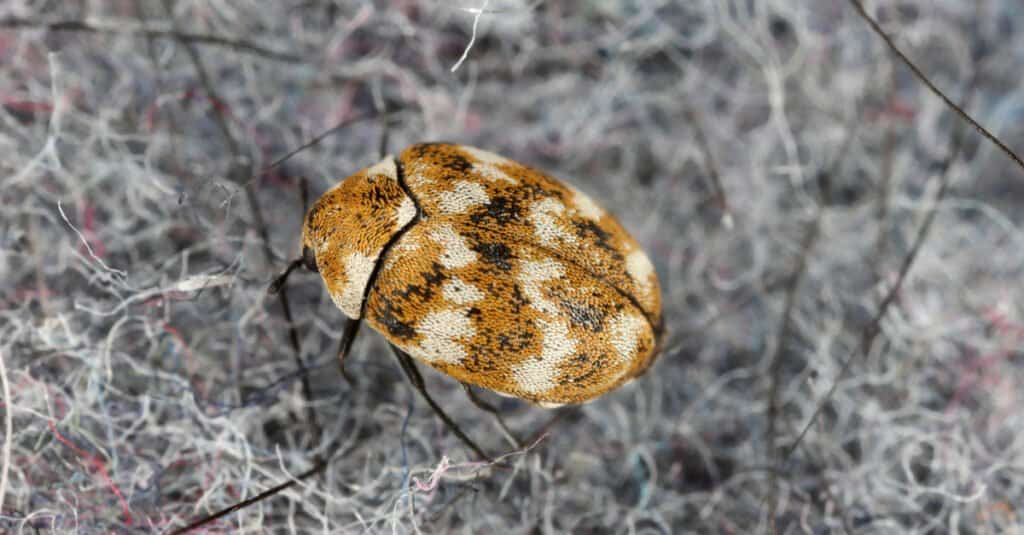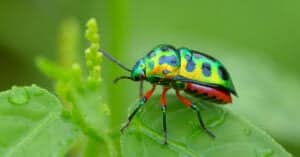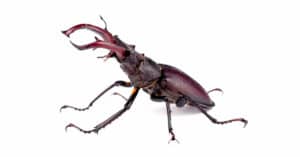Have you heard of carpet beetles? They are typical domestic pests that attack clothing, home furniture, and carpets. Three types of carpet beetles can be found in U.S. homes: the black carpet beetle, the furniture carpet beetle, and the diversified carpet beetle.
The oblong-shaped larvae range in color from reddish-brown to black. They have numerous short hairs that protrude from their bodies and lighter-colored stripes down their back. An infestation of carpet beetles can result in substantial destruction of property if left untreated.
How Do Carpet Beetles Get Into Homes?
When an object is brought inside that is already infested, such as furniture, a plant, deliveries in boxes, or on pet fur, carpet beetles can enter the house through an open door or window or on that object’s surface. The taxonomy industry is another well-liked breeding ground for carpet beetles.
Adults will fly in through open windows or doors to lay their larvae on furniture, clothing, rugs, or carpets since they enjoy fabric and animal products. They can readily flourish in the home if left unattended and the environment is not maintained clean and sanitized.
Are Carpet Beetles Dangerous?

Carpet beetles are highly destructive to fabrics and furniture.
©Levente Nuber/Shutterstock.com
Larvae can destroy natural fibers when they feed, leaving holes in blankets and clothing. The bristly hairs on garments can itch human skin if they have adhered to it. They are safe for anyone to use, save from minor skin discomfort.
Most of the time, they primarily harm the inside items like furniture, carpeting, and bedding rather than the actual home. The issue can worsen if they are allowed to reproduce. Generally, they won’t hurt humans.
Signs Your Home Has Carpet Beetles
Thankfully, several signs are easy to spot that a carpet beetle has made itself at home. Here are some of the most common ways they make themselves known.
Holes in Fabric
If you’re unlucky, you might also discover that these pests eat through your clothes, blankets, towels, and linens. Your clothing, scarves, jackets, and blankets may become damaged by the larvae of carpet beetles that get inside your wardrobes.
They typically rip or tear holes in huge groups or clusters in garments. Contrarily, clothing moths, another pest that preys on textiles, tend to nibble along the surface of materials, making only minor, occasional holes.
Due to their preference for secluded, gloomy environments, larvae are more likely to be discovered eating fabrics and items that have been put away or left unattended for a long time.
Fecal Matter
Little fecal pellets, which resemble specks about the size of table salt, are the waste products that carpet beetle larvae leave behind after feeding.
Their feces are generally black or brown, which might vary depending on their most recent food color. Fecal pellets from them are typically seen in regions where they feed, just like shed skins are.
Old Skin Casings
Carpet beetles molt and shed multiple times as they develop, leaving behind vacant skin shells. A carpet beetle’s lost skin often has a transparent appearance and a yellow or brown color. Based on the species and shedding stage, the size of these dry, hollow shells, which resemble sunflower seeds, might vary.
A carpet beetle’s exoskeleton can initially resemble a bed bug’s exoskeleton. Their shapes can distinguish the two; bed bug shells are rounder, and carpet beetle casings are longer.
In locations where carpet beetle larvae feed, such as under carpets, under stacks of clothing or blankets, and along the seams of furniture, shed skins will most likely be found.
Skin Problems
Although carpet beetle doesn’t bite people, they can cause skin itchiness, welts, or rashes; this condition is known as “carpet beetle dermatitis.” Some people may experience these sensations as an allergic response to the hemolymph and hair of carpet beetle larvae.
Larvae have hair that protrudes out of their skin in various directions from every part of their body. The hairs come off when they mature, shed their skin, and remain on the carpet or other things they were feasting on. These hairs may cause an acquired hypersensitive reaction over time, culminating in the symptoms mentioned above.
Damage to Fibrous Textiles
Larvae may feast on numerous products and materials when they invade your house. Although carpet beetle larvae will chew their way through any fiber materials with keratin, including wool, fur, felt, satin, feathers, and leather, they are most known for being a threat to carpeting.
Larvae typically skim across the top and bottom of carpets and rugs as they consume them, leaving behind bald spots or fraying. Since wool was the primary material used to make carpets, the term “carpet beetle” originated. They are not fed by modern synthetic-material carpeting.
How to Get Rid of Carpet Beetles

One should store clothes in an airtight container to protect one’s clothing from carpet beetles.
©Tomasz Klejdysz/Shutterstock.com
We get it — nobody wants carpet beetles in their home! Luckily, there are plenty of ways to eliminate these pesky critters. Here’s how to do just that.
Insecticide
Use an insecticide on carpeting or upholstery with at least one of the following ingredients: deltamethrin, bifenthrin, or cyfluthrin to terminate an active larval infestation. Before treating the entire carpet, conduct a test in a discrete area to be sure it won’t stain. Many insecticides warn about using them near humans or animals, so heed them.
Boric Acid
While it’s a popular way to get rid of ants, boric acid also works for them. Only when consumed or inhaled in significant amounts is boric acid dangerous to people because it poisons the metabolism of insects.
You can buy it in powder form in drugstores or the supermarket’s laundry section. It should be evenly sprinkled throughout the carpet before brushing or sweeping into the fibers. Wait several hours before doing a thorough vacuum.
A spoonful of boric acid and two cups of boiling water can also make a spray that kills larvae. Stir the mixture until the powder is dissolved. Use the solution to spray baseboards, drapes, upholstery, and any other dark crevices and corners with a disposable spray bottle.
Insect Fogger
Do you have adult carpet beetles? They can be annoying since they fly around the house even if they are no longer nibbling on your things. Most importantly, if left unattended, they can lay eggs and begin the unpleasant cycle again. To efficiently get rid of adult beetles, use a flying insect fogger and have flying bug spray on hand to get rid of strays or newbies.
Regular Vacuuming
They can be eliminated by routine vacuuming, often even before they have a possibility of causing much harm. Use the proper accessories to clean upholstery and curtains and to reach into nooks. Steam cleaning your house will kill larvae and eggs, and then vacuum them up as heat is another effective tool against carpet beetles.
Diatomaceous Earth
Diatomaceous earth is another natural product that swiftly kills dehydrating larvae. It is sold in agricultural-feed stores and by several internet vendors. Boric acid should be applied to rugs using the manner above, and some should also be sprinkled in pet beds, the backs of cabinets, and wardrobes.
Use “food grade” diatomaceous earth, which is safe for both people and animals, but use it while wearing a respirator or mask to avoid breathing in the tiny dust particles.
Vinegar
Vinegar works well to repel them, and it doesn’t matter which kind you use. Fill an empty spray bottle with pure vinegar and mist it liberally over clothing, carpets, linens, and furniture. You may want to wash any items kept in a closet or dresser drawers that show evidence of a carpet beetle infestation to get rid of any larvae or eggs that may be present.
Preventing Future Infestations
Once they are gone, take a few preventive measures to prevent them from returning. Hang adhesive flypaper strips near windows to deter adult carpet beetles from entering your home. Sticky pheromone-type traps can be placed on window ledges and closets to prevent carpet beetles from laying eggs if you frequently deal with outbreaks.
Because they like to feed on filthy fabrics and remove spills, moisture, and other contaminants from clothing before storage. Noodles and flour should always be kept in sealed containers. Maintain a weekly dusting, mopping, and vacuuming routine to prevent carpet beetles from settling in your house.
The photo featured at the top of this post is © Tomasz Klejdysz/Shutterstock.com
Thank you for reading! Have some feedback for us? Contact the AZ Animals editorial team.






